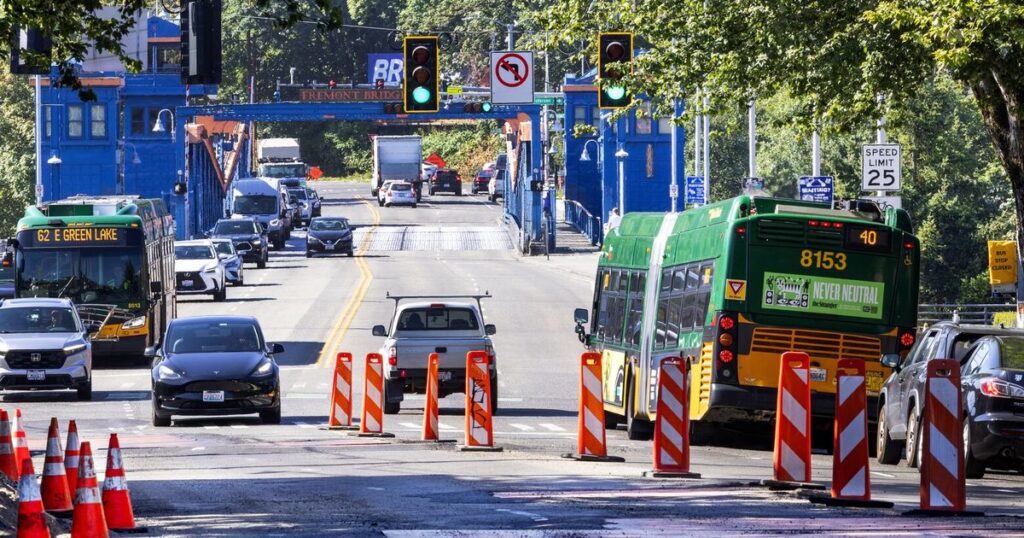The Fremont Bridge isn’t just busy — it is without doubt one of the busiest drawbridges in North America. The Seattle Division of Transportation’s plan to create a bus-only lane by way of Fremont and alongside Westlake will improve congestion and visitors, severely impacting residents, native companies and everybody passing by way of, with out considerably bettering bus journey occasions.
For greater than a century, the Fremont Bridge has served as each a literal and symbolic gateway between neighborhoods. Opened in 1917, the bridge connects Queen Anne and Downtown Seattle to Fremont, Wallingford, Ballard and the communities to the north. This bright-blue-and-orange double-leaf drawbridge features as an important artery not just for commuters on land but additionally for marine visitors passing beneath its low-slung deck. From trolleys and horse-drawn carriages to right this moment’s fixed circulate of automobiles, buses, bicycles and pedestrians, the bridge stays a civic hub, linking commerce, tradition and group.
But, regardless of its appeal and performance, the Fremont Bridge stays considered one of Seattle’s nice paradoxes. Sitting solely 30 toes above water, it opens about 40 occasions every day to let tugboats, fishing vessels and leisure boats move by way of the Ship Canal’s waters. This lifting and ready has made it a logo of each affection and frustration, uniting and delaying us on the similar time, and serving as a metaphor for our ever-expanding metropolis and the rising pains that include it.
On prime of the busy maritime visitors under and vehicular visitors above, the bridge serves as an important artery for Seattle’s vibrant biking group. Each ends of the bridge have intersections which can be among the many busiest for bikes on all the West Coast. On any day, hundreds of cyclists move by way of these crossings. It is usually the busiest pedestrian crossing of all of the bridges throughout the water from Montlake to Ballard, establishing the Fremont Bridge as a regional hub for all modes of transportation.
Including one other layer of complexity is the core problem of lane capability. The Fremont Bridge is considered one of Seattle’s most extreme visitors bottlenecks. With solely two lanes in every course and three main arterials from the south — Westlake and Dexter avenues and Nickerson Road — and 4 main arterials to the north — North thirty fourth and thirty fifth streets, Fremont Avenue North and Leary Manner that land immediately at its base — there isn’t any bodily house for enlargement. Not like the neighboring College and Ballard bridges, the bridge’s quick decking supplies solely restricted loading capability. Each time the Fremont Bridge opens, all visitors stops.
This isn’t an anti-bus op-ed. Our group helps and welcomes most facets of the Route 40 Transit-Plus Multimodal Corridor project. Upgrades to curb ramps and pedestrian crossings will enhance security and accessibility. The addition of a safer bike connection heading north on Fremont is a constructive and wanted step for safer journey. We would like a powerful and wholesome bus community to be a key a part of our transportation choices. Nevertheless, the proposal to create a full-time bus-only lane within the Fremont core will trigger important impacts that we imagine haven’t been absolutely addressed. Slicing the capability for normal visitors will inevitably improve congestion and hinder freight, emergency response and native automobile motion. Neighborhoods from Ballard to South Lake Union depend upon this route, and the ensuing gridlock will create ripple results all through all the hall. Elevated congestion and restricted entry will even hurt our small enterprise group by discouraging clients, delaying important deliveries and threatening livelihoods, particularly in an space already going through ongoing development challenges and diminished parking choices. A transit plan that ignores Fremont’s realities is a plan destined to stall.
Fremont will not be opposed to alter. Our group has lengthy championed modern and inclusive infrastructure options. However on this case, we urge metropolis leaders to rethink the proposed bus-only lane and as an alternative pursue methods that adapt to Fremont’s distinctive belongings and limitations, moderately than imposing a one-size-fits-all method. In spite of everything, nobody desires the Heart of the Universe to break down underneath its personal gravity.
Editor’s word: The headline on this story has been up to date to replicate the place the bus lane is proposed.

